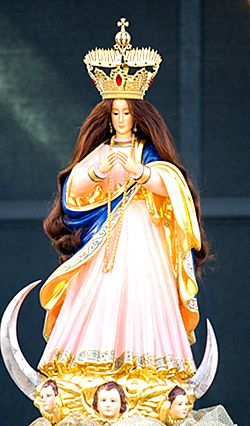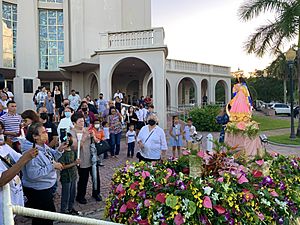Santa Marian Kamalen facts for kids
Quick facts for kids Our Lady of CamarinSanta Marian Kamalen, Maga Haga |
|
|---|---|

The venerated image enshrined at the Minor Basilica of Most Sweet Name of Mary
|
|
| Queen and Patroness of Guam | |
| Venerated in | Roman Catholic Church |
| Major shrine | Cathedral-Basilica of the Most Sweet Name of Mary |
| Feast | December 8, Feast of the Immaculate Conception |
| Attributes | The Blessed Virgin Mary on crescent moon |
| Patronage | Guam and Guamanian people, Mariana Islands |
Santa Marian Kamalen, also called Our Lady of Camarin, is a special statue of the Blessed Virgin Mary. People in Guam who are Roman Catholic honor this statue as their Patroness. It is made from molave wood and ivory.
This important statue survived the Japanese war and the bombing of Guam on December 8, 1941. This date is also the Feast of the Immaculate Conception. Today, the statue is kept safely at the Minor Basilica of the Most Sweet Name of Mary.
Contents
What is the History of Santa Marian Kamalen?
Many stories say that the statue came to Guam on a Galleon ship called Nuestra Señora del Pilar de Zaragoza y Santiago. This ship was shipwrecked on June 2, 1690, near Cocos Island in Guam. Sailors on the ship likely kept the statue there.
How Was the Statue Discovered?
One popular story tells of a fisherman who found the statue along the shore of Merizo. He saw the statue with crabs around it, holding what looked like small candles. Local people believed this was a miracle. The statue later got the name Kamalen, which means Barracks. This is because it was stored in a nearby army building after the fisherman found it.
What Does the Statue Look Like?
The statue is about 28 inches tall and weighs 48 pounds. It is made of painted Molave wood, and its head and hands are made of ivory. It even wears a wig of human hair.
During the start of Second World War on December 8, 1941, people who cared for the statue hid it to keep it safe. The statue was returned to the cathedral on December 8, 1945, again on the Feast of the Immaculate Conception.
In 1948, the statue was taken to the Philippines to be fixed by a famous artist named Máximo Vicente. He also worked on the Black Nazarene statue in Quiapo.
Did the Statue Survive a Natural Disaster?
Another well-known story says the statue survived a big earthquake in Guam in 1902. The earthquake destroyed the church and many other statues inside. But the Santa Marian Kamalen statue was left unharmed.
How is Santa Marian Kamalen Honored Today?
The statue was stolen three times: on May 19, 1968, May 3, 1971, and December 28, 1992. Each time, it was later returned. A copy of the statue is displayed for people to see in the main church. The original ivory statue is kept high above the main altar.
Today, the original statue hangs high above the main altar. It is protected by a digital alarm system. Only the main caretaker of the statue can access it. Behind its special spot are three locked doors. You can only reach them by a staircase through an old entrance.
Pope John Paul II talked about the statue on February 22, 1981, during his visit. A copy of the statue was also placed in the Basilica of the National Shrine of the Immaculate Conception in Washington D.C. on September 17, 2006.
See also
 In Spanish: Santa María de Kamalen para niños
In Spanish: Santa María de Kamalen para niños


